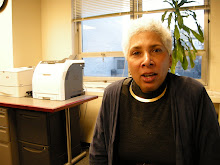Bridge is more than a card game.
When my first thought came to learn to play Bridge, I thought it was a card game. Perhaps you think so. This is my third semester at JASA. My teacher Mark Hyman hold the Manhattan Bridge Club Championship for 2006. He gives a lecture on a segment of the guidelines called rules. Then he passes out a set of already dealt cards. Based on the mornings lecture he watches us play. The "dealer" is marked as we pick up our thirteen cards. WE bid. Bidding is a prediction, a gamble.
That was my first clue that Bridge is not a card game. It is much more than four people sitting at a card table with fifty two cards between them. This bidding is called an auction. Each partnership, each two of the four players bids in the auction for the contract. The contract determines the score the partnership will make. This essay is not a detailed discussion of how to play Bridge. It is certainly not about how to score because I have not learned how to score.
This sounds strange to have a card game not yet about scoring. $180 later; Bridge is not just one game. It is several games in one.
First: the bidding
The play of the cards to win tricks
The scoring
The etiquette, the social aspect
A trick is stacking four cards on your side of the table. This bidding is about winning tricks. There are five ways to win tricks:
Ø highest card
Ø length in a suit
Ø finessing
Ø promotion
Ø trumping
To bid the two partners converse in a convoluted though mathematical syntax. If they predict the number of winning tricks they win points. This intriguing conversation is spoken in a hierarchy of suits: no trump, spades, hearts, diamonds and clubs, with a number. You describe your prediction to your partner with a number and a strain (a suit) This is calculated by counting the points in your hand primarily. Counting and recounting. This conversation is encrypted with bravado as one partner queries and the other partner responds. Then suddenly the other twosome partnership jumps into the auction.
If your partnership wins the contract one of you will play the cards form both hands. You may playa no trump game or a trump game. In no trump the highest card wins in all suits. In a trump game only the contracted suit wins. In order to win your contract you must plan. Planning means
Ø Deciding when to draw trumps
Ø When to play the higher cards
Ø When to ruff
Ø When to finesse
Ø When to promote
And most important
Ø when and how to lead from your hand.
The other two players, the defense do the same planning. This is all very unpredictable because every hand you are dealt is different. There are one quintillion possible hands to be dealt. That is 10 to the18th power Six sets of three zeros.
The social and emotional aspects of Bridge are immediately essential. You need four people, a quiet space a card table and four chairs. Bridge was played at JASA for many semesters with a board laid between four chairs.
The four players may not always be you friends, but you will need etiquette to control your conduct during the game. Emotional comments and chitchat are limited. This cordiality implies nice clothes and especially jewelry. The money spent can be on paying to play socially or tournaments, lessons, supervised play, books and unique playing cards.
What is called Bridge is a social activity that is many faceted.
Ø Memory: what to bid, what to respond?
Ø Mathematics: counting points in your hand and imagining the opponents' points
Ø Mindful strategy: when to play which card?
Ø Musical chairs: as you travel to play around town.
There are challenges to last a lifetime. One quintillion challenges!
Thursday, April 15, 2010
Subscribe to:
Post Comments (Atom)

No comments:
Post a Comment